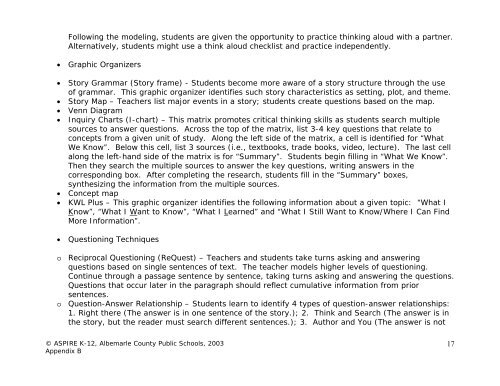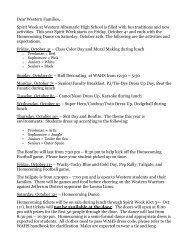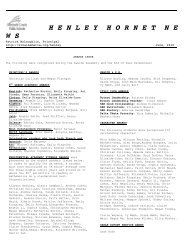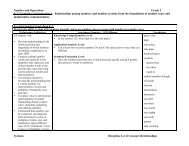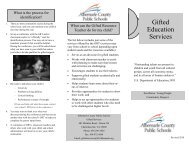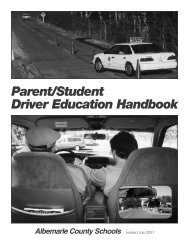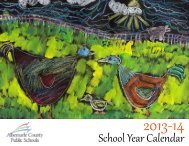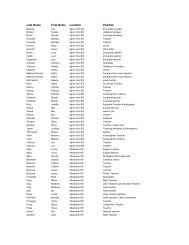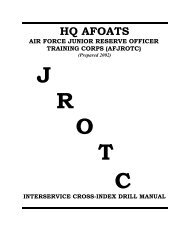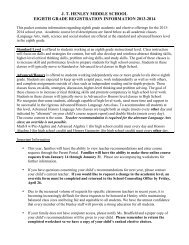Language Arts/English Curriculum Frameworks - Albemarle County ...
Language Arts/English Curriculum Frameworks - Albemarle County ...
Language Arts/English Curriculum Frameworks - Albemarle County ...
You also want an ePaper? Increase the reach of your titles
YUMPU automatically turns print PDFs into web optimized ePapers that Google loves.
Following the modeling, students are given the opportunity to practice thinking aloud with a partner.<br />
Alternatively, students might use a think aloud checklist and practice independently.<br />
• Graphic Organizers<br />
• Story Grammar (Story frame) - Students become more aware of a story structure through the use<br />
of grammar. This graphic organizer identifies such story characteristics as setting, plot, and theme.<br />
• Story Map – Teachers list major events in a story; students create questions based on the map.<br />
• Venn Diagram<br />
• Inquiry Charts (I-chart) – This matrix promotes critical thinking skills as students search multiple<br />
sources to answer questions. Across the top of the matrix, list 3-4 key questions that relate to<br />
concepts from a given unit of study. Along the left side of the matrix, a cell is identified for “What<br />
We Know”. Below this cell, list 3 sources (i.e., textbooks, trade books, video, lecture). The last cell<br />
along the left-hand side of the matrix is for “Summary”. Students begin filling in “What We Know”.<br />
Then they search the multiple sources to answer the key questions, writing answers in the<br />
corresponding box. After completing the research, students fill in the “Summary” boxes,<br />
synthesizing the information from the multiple sources.<br />
• Concept map<br />
• KWL Plus – This graphic organizer identifies the following information about a given topic: “What I<br />
Know”, “What I Want to Know”, “What I Learned” and “What I Still Want to Know/Where I Can Find<br />
More Information”.<br />
• Questioning Techniques<br />
o Reciprocal Questioning (ReQuest) – Teachers and students take turns asking and answering<br />
questions based on single sentences of text. The teacher models higher levels of questioning.<br />
Continue through a passage sentence by sentence, taking turns asking and answering the questions.<br />
Questions that occur later in the paragraph should reflect cumulative information from prior<br />
sentences.<br />
o Question-Answer Relationship – Students learn to identify 4 types of question-answer relationships:<br />
1. Right there (The answer is in one sentence of the story.); 2. Think and Search (The answer is in<br />
the story, but the reader must search different sentences.); 3. Author and You (The answer is not<br />
© ASPIRE K-12, <strong>Albemarle</strong> <strong>County</strong> Public Schools, 2003<br />
Appendix B<br />
17


